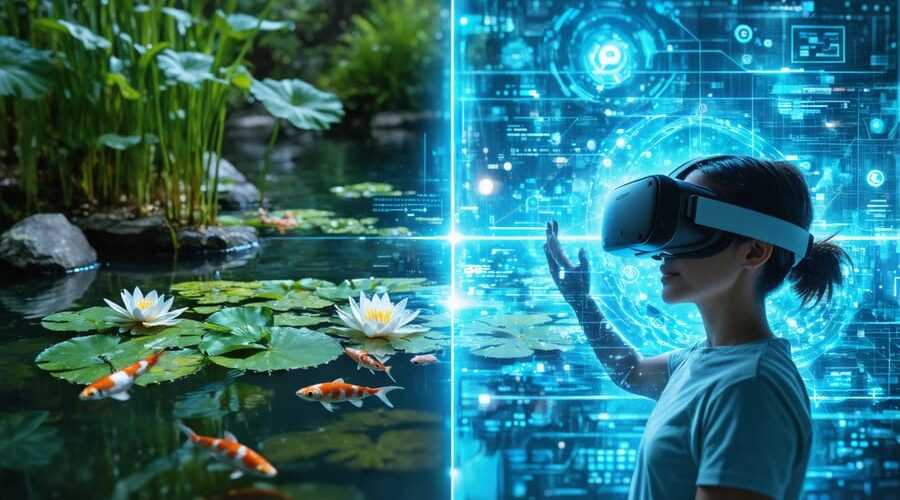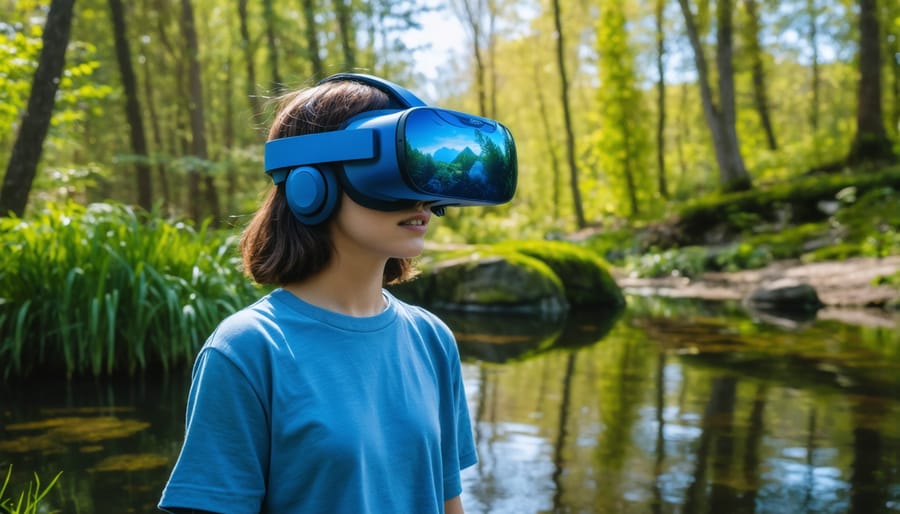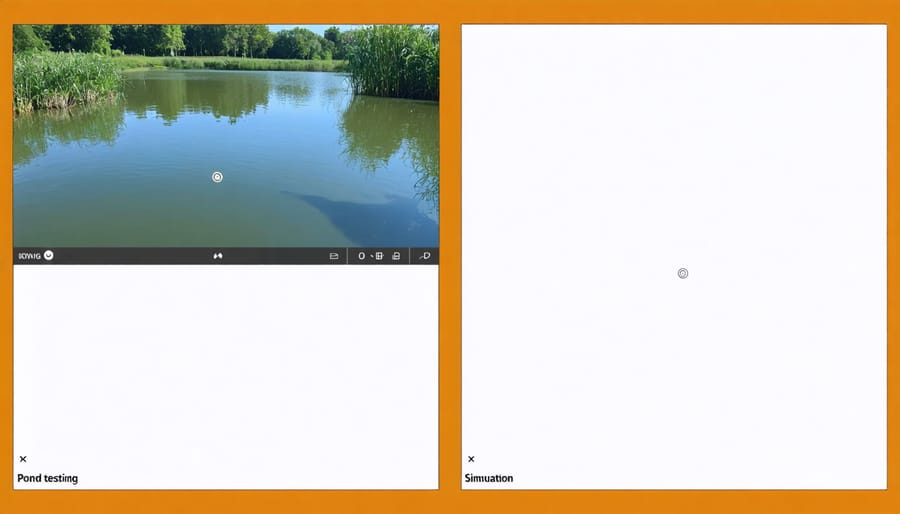
Virtual Reality Makes Perfect Pond Management Real (Without Getting Your Feet Wet)
Virtual reality training simulations are revolutionizing the way we learn complex skills, combining immersive technology with hands-on practice in risk-free environments. From medical procedures to smart pond management, VR training offers unprecedented opportunities to master challenging tasks without real-world consequences.
Picture yourself performing intricate surgical procedures, navigating emergency response scenarios, or mastering heavy machinery operations – all from the safety of a virtual environment. This technology doesn’t just simulate experiences; it creates muscle memory, builds confidence, and accelerates learning curves through repetitive practice and instant feedback.
The impact is transformative: studies show VR-trained individuals learn up to 4 times faster than traditional methods, retain information 75% better, and demonstrate significantly improved performance in real-world applications. For businesses, this translates to reduced training costs, minimized risks, and consistently skilled workforce development.
As VR hardware becomes more accessible and software more sophisticated, these training solutions are no longer limited to large corporations or specialized industries. They’re becoming essential tools for anyone seeking to develop expertise in their field, from hobbyists to professionals, marking a new era in experiential learning.
How VR Pond Training Actually Works

The Virtual Pond Environment
The virtual pond environment delivers an incredibly lifelike experience through advanced 3D modeling and sophisticated water physics. Each element, from the rippling surface to underwater plant movement, is meticulously crafted to behave just like a real pond. The simulation uses real-time fluid dynamics to accurately represent how water flows, splashes, and interacts with objects, making maintenance tasks feel authentic and natural.
Users can observe how different weather conditions affect the water, including wind-created waves and rain impacts. The environment includes detailed models of common pond features like filters, pumps, and lighting systems, all rendered with high-definition textures that respond realistically to light and shadow. Underwater visibility changes based on water clarity, and fish movements are programmed to mirror natural behaviors.
The physics engine calculates water pressure, flow rates, and temperature variations, helping users understand how these factors influence pond health. This attention to detail ensures that skills learned in the virtual environment transfer effectively to real-world pond management, making it an invaluable training tool for both beginners and experienced pond keepers.
Interactive Training Elements
Virtual reality training simulations offer an immersive experience through various interactive elements that mirror real-world tools and controls. Trainees can reach out and grab virtual objects, manipulate equipment, and perform tasks using natural hand movements tracked by VR controllers. These controllers often feature haptic feedback, providing realistic sensations when touching or handling virtual items.
The simulations typically include detailed control panels, allowing users to adjust settings, monitor readings, and operate machinery just as they would in real life. Virtual tools range from basic hand tools to complex diagnostic equipment, each responding accurately to user input. Multi-touch interfaces enable intuitive interactions like pinching to zoom, rotating objects, and sliding controls.
Voice commands add another layer of interaction, letting users navigate menus or activate functions hands-free. Many simulations also incorporate gesture recognition, where specific hand movements trigger corresponding actions in the virtual environment. These interactive elements work together to create a natural, intuitive learning experience that helps users develop muscle memory and practical skills they can apply in real-world situations.
Real Skills You’ll Learn in Virtual Reality
Water Quality Management
Virtual reality training offers an immersive environment where pond enthusiasts can practice essential water quality maintenance without the risks associated with real-world mistakes. Through realistic 3D simulations, users can test different water treatment scenarios and observe their immediate effects on the pond ecosystem.
The training modules typically start with basic water testing procedures, allowing users to virtually collect samples and analyze parameters like pH, ammonia, and dissolved oxygen levels. As users progress, they encounter various water quality challenges, from algae blooms to fish health issues, requiring them to make quick decisions and apply appropriate treatments.
What makes these simulations particularly valuable is their ability to compress time, showing the long-term effects of treatment choices in minutes rather than weeks. Users can experiment with different chemical dosages, filtration adjustments, and treatment combinations to see how their decisions impact water clarity, fish health, and plant growth.
The interactive nature of VR training helps develop muscle memory for proper testing techniques and equipment handling. Users can practice measuring exact chemical doses, calibrating testing equipment, and following safety protocols in a risk-free environment. This hands-on experience builds confidence before working with actual pond treatments and helps prevent costly mistakes in real-world applications.

Plant and Fish Care
Virtual reality training offers an immersive way to master plant and fish care without risking your actual pond’s health. Through detailed simulations, you can practice maintaining a thriving pond ecosystem while learning from virtual scenarios that mirror real-world challenges.
The simulation allows you to experiment with different plant combinations, observe growth patterns, and understand how various species interact. You can adjust water parameters, practice identifying common fish diseases, and learn appropriate treatment methods without the stress of making mistakes on live specimens.
What makes these VR experiences particularly valuable is their ability to compress time. You can witness months of plant growth in minutes, understand seasonal changes, and see how your decisions impact the ecosystem over time. The software presents various challenges, from sudden algae blooms to fish health issues, teaching you to think critically and act quickly.
Interactive tutorials guide you through essential maintenance tasks like proper plant pruning, fish feeding schedules, and water quality management. You’ll learn to recognize early warning signs of common problems and develop confidence in your problem-solving abilities. The hands-on practice in this safe, virtual environment helps build muscle memory for real-world application while eliminating the risk of costly mistakes in your actual pond.

Benefits of VR Training for Pond Owners
Risk-Free Learning
Virtual reality training provides a safe, consequence-free environment where pond enthusiasts can experiment and learn without risking damage to actual water features. Think of it as a digital sandbox where mistakes become valuable learning opportunities rather than costly setbacks. Whether you’re learning about pump installation, filter maintenance, or preventive pond maintenance, VR simulations let you practice these skills with confidence.
Imagine being able to drain and refill a pond multiple times, adjust chemical levels, or handle emergency situations without worrying about harming real fish or plants. VR training allows you to repeat procedures until you’ve mastered them, building muscle memory and confidence before working on your actual pond.
The simulation environment also presents various scenarios and challenges that might take years to encounter in real life. You can experience different seasons, weather conditions, and common pond problems in compressed time, gaining valuable experience without the wait. This risk-free approach is particularly beneficial for beginners who might feel intimidated by hands-on maintenance tasks or for experienced pond owners looking to expand their skills into more complex areas of pond management.
Time and Cost Savings
Virtual reality training simulations offer significant cost advantages over traditional training methods. By eliminating the need for physical equipment, travel expenses, and facility rentals, organizations can reduce their training budgets substantially. Studies show that companies implementing VR training programs typically see a 30-50% reduction in overall training costs.
The time savings are equally impressive. Trainees can practice complex procedures repeatedly without consuming actual resources or requiring instructor supervision for every session. What might take weeks to learn through conventional methods can often be mastered in days using VR simulations. Multiple learners can train simultaneously in different virtual environments, maximizing efficiency and reducing scheduling conflicts.
Additionally, VR training reduces workplace disruption since employees can practice during off-peak hours or from remote locations. The ability to record and review training sessions helps identify areas for improvement quickly, streamlining the learning process. Equipment maintenance costs are also minimized, as virtual systems require only software updates rather than physical repairs or replacements.
For businesses, these combined savings translate to faster employee onboarding, reduced downtime, and improved operational efficiency. The initial investment in VR technology typically pays for itself within the first year through decreased training expenses and improved productivity.
Getting Started with VR Pond Training
Getting started with VR pond training is easier than you might think! First, ensure you have a compatible VR headset – popular options include the Meta Quest 2, HTC Vive, or Valve Index. Once you have your hardware ready, download a pond management simulation app from your headset’s app store or training platform.
Before diving in, create a comfortable space with enough room to move around safely – about 6×6 feet should do it. Put on your headset and follow the initial setup tutorial, which will help you get familiar with the basic controls and movement mechanics.
Start with the beginner tutorials, which typically cover pond basics like water testing, fish identification, and plant placement. These foundational modules use interactive 3D models that you can grab, rotate, and examine from all angles. Take your time to explore each element – there’s no rush!
As you progress, you’ll unlock more advanced scenarios that simulate real-world challenges like algae control, filter maintenance, and seasonal transitions. The beauty of VR training is that you can practice these skills repeatedly without any real-world consequences.
Don’t forget to take regular breaks – 15 minutes of rest for every hour of VR use is recommended. Keep notes of what you learn in each session, as this helps reinforce the knowledge when you’re working on your actual pond.
Join online communities of other VR pond enthusiasts to share experiences and tips. Many training platforms offer multiplayer features where you can learn alongside others or get guidance from experienced pond keepers in virtual environments.
Remember, VR training is a supplement to hands-on experience, not a replacement. Use what you learn in the virtual world to build confidence before tackling real-world pond management tasks.
Virtual reality training has revolutionized the way we learn and master pond management skills. By providing a risk-free environment to practice crucial maintenance tasks, VR simulations have made it easier than ever for pond enthusiasts to gain confidence and expertise. The immersive nature of VR training allows users to develop muscle memory and understanding of proper techniques without the fear of making costly mistakes in real-world situations.
The impact of VR training extends beyond basic skill development. Users who have embraced this technology report feeling more prepared to handle complex situations, from water quality management to fish health assessments. The ability to practice scenarios repeatedly, receive instant feedback, and learn from mistakes has significantly shortened the learning curve for many pond owners.
As VR technology continues to advance, we can expect even more sophisticated training simulations that will further enhance the learning experience. Whether you’re a beginner just starting your pond journey or an experienced enthusiast looking to refine your skills, virtual reality training offers an invaluable tool for achieving pond management success. The future of pond care education is here, and it’s more accessible and effective than ever before.
